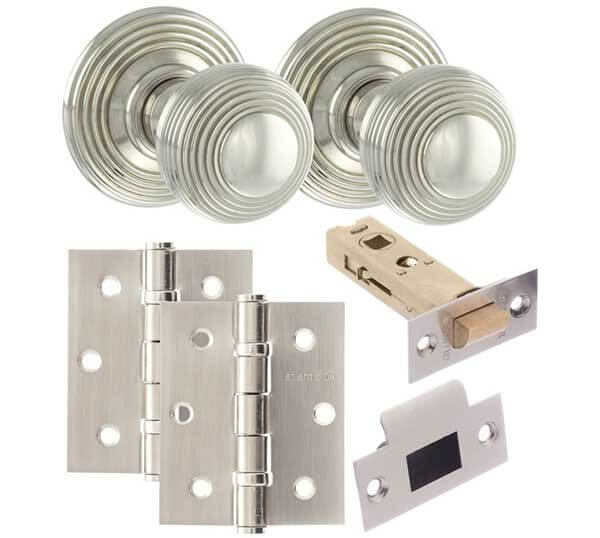How To Safely Remove Paint from Door Hardware
Key Takeaways
| Method | Best For | Time Required | Difficulty |
|---|---|---|---|
| Water Soak | Oil and latex-based paints | 12+ hours | Easy |
| Baking Soda Boil | Stubborn paint | 30-60 minutes | Medium |
| Paint Scraper | Smooth surfaces, light paint | 15-30 minutes | Medium |
Introduction
The doors in your home are not just functional portals separating rooms; they are potentially beautiful, artful pieces of design. This is especially true for older, ornate period doors, which can add a gorgeous accent to any home. However, restoring these doors to their original glory can be a challenging task.
One of the most common restoration techniques is removing paint from door locks, handles, knockers, and hinges that might have been applied over the years, either intentionally or by accident. Using harsh chemicals such as paint stripper in these instances is not recommended, as the caustic nature of the chemicals could damage the metal, leave tell-tale 'smears' behind, and prove dangerous if you inhale the fumes or get any on your skin.
This guide will explore a few simple, non-invasive paint removal techniques that use conventional household products and are better for both the environment and your door hardware.
Tools and Materials
- Slow cooker or old cooking pot
- Baking soda
- Utility knife or paint scraper
- Clean cloths
- Metal polish
- Protective gloves
- Safety goggles
- Well-ventilated workspace
Preparation Steps
- Remove the hardware from the door
- Clean the hardware with soap and water to remove dirt and grime
- Dry the hardware thoroughly
- Set up your workspace in a well-ventilated area
- Put on protective gloves and safety goggles
Paint Removal Methods
1. Water Soak Method
This method is ideal for oil and latex-based paints.
Steps:
- Fill a slow cooker with water
- Place the hardware in the water
- 'Cook' on low heat for 12 hours (overnight)
- Remove the hardware and scrub off the weakened paint
- Polish and reattach the hardware
Note: Be cautious with steel hardware, as prolonged soaking may cause rusting, especially if there are visible cracks in the coating.
2. Baking Soda Boil Method
This method is effective for more stubborn paint.
Steps:
- Fill an old cooking pot halfway with water
- Add a layer of baking soda to cover the bottom
- Place the hardware in the pot, ensuring it's covered with water
- Heat on low to medium until simmering
- Reduce heat and simmer for 30 minutes
- Remove hardware and peel off softened paint
- If needed, boil for longer
- Dispose of the water and baking soda mixture
- Polish the metal with a clean, dry cloth
3. Paint Scraper Method
This method works well for smooth surfaces with light paint coverage.
Steps:
- Use a utility knife to cut around the hardware's outer edge
- Carefully scrape away the paint with a flat blade
- For stubborn areas, try one of the above methods
Safety Precautions
- Always work in a well-ventilated area
- Wear protective gloves and safety goggles
- Be cautious of older paints, which may contain lead
- Dispose of removed paint properly
- Never reuse pots used for paint removal for cooking
Aftercare and Finishing Touches
- Clean the hardware thoroughly after paint removal
- Use a metal polish to restore shine
- Apply a protective coating if desired
- Reattach the hardware carefully to avoid scratching
When to Consider New Doors
While restoring door hardware can breathe new life into your existing doors, there may be instances where purchasing new doors is the best option. Consider new doors if:
- Your current doors are severely damaged or warped
- You're looking to upgrade the style or material of your doors
- You need to improve energy efficiency or security
- The cost of restoration exceeds the value of the current doors

Suffolk Cottage Style Oak Door
A charming oak door with a cottage-style design, adding rustic elegance to your home.
At Internal Doors, we offer a wide range of high-quality internal doors to suit various styles and needs. From classic wooden doors to modern glass designs, our selection ensures you'll find the perfect fit for your home. Browse our collection to find doors that complement your newly restored hardware or to completely refresh your interior design.
Frequently Asked Questions
Q: Can these methods damage the hardware?
A: If done carefully, these methods should not damage most hardware. However, always test on a small, inconspicuous area first.
Q: How do I know if the paint contains lead?
A: Lead paint was commonly used before 1978. If you're unsure, use a lead testing kit or consult a professional.
Q: Can I use these methods on painted wooden doors?
A: These methods are specifically for metal hardware. For wooden doors, different techniques are required.
Conclusion
Removing paint from door hardware can be a rewarding DIY project that enhances the beauty of your doors. By using these safe, environmentally friendly methods, you can restore your door hardware to its original glory without resorting to harsh chemicals. Remember to always prioritise safety, work in a well-ventilated area, and dispose of paint residue properly. With patience and care, your restored door hardware will add a touch of elegance to your home for years to come.













